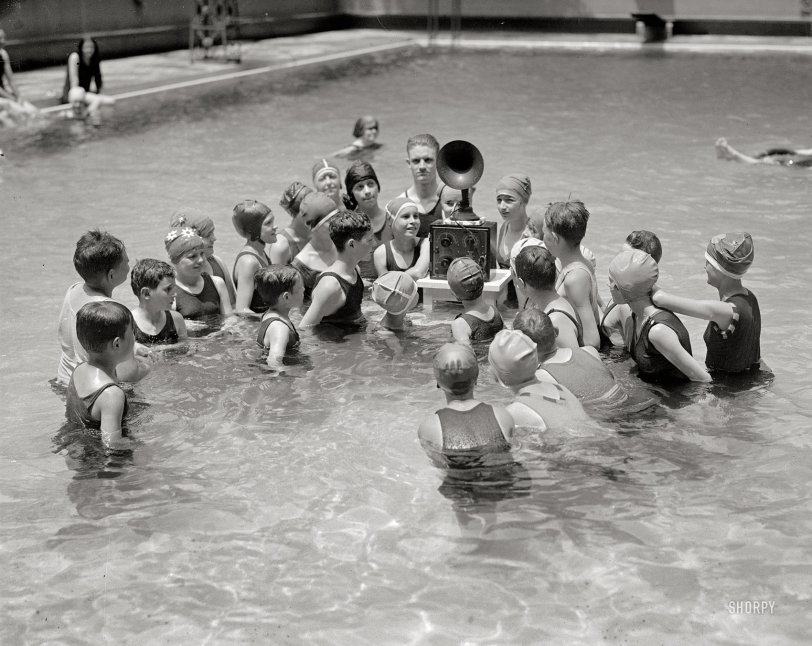


Framed or unframed, desk size to sofa size, printed by us in Arizona and Alabama since 2007. Explore now.
Shorpy is funded by you. Patreon contributors get an ad-free experience.
Learn more.

- If You’re Like Me, Never
- U.S.A.
- S&P
- 1940 Zenith radio model 6G601
- Quality goes in before the name goes on!
- Snazzy skirt
- Carbon Arc Lamps
- Illuminate us
- I remember it well
- I can't prove it
- Complicated then, forgotten now
- Bryan-Stevenson
- Skinny is as skinny does
- How do you rest in peace
- Riding the footboards
- Alas, hidden from view
- Baldwin Diesels
- Exclusive pump
- Bananas, Oysters and Smokey Joe
- Details, Details
- What's that building to the left of the tower?
- Coal Barges
- Bromo-Seltzer
- Inner harbor
- The Basin
- What a headache!
- Giant stepladder?
- Yeah, it was cold
- Love those coats
- Link & Pin Days Remnant
Print Emporium
Wateradio: 1924

July 10, 1924. Washington, D.C. "Radio at Wardman Park Hotel pool" -- 85 years ago today. National Photo Company Collection glass negative. View full size.
Which Station?
I've been trying to narrow down the radio station they were listening to. With the wavelength (lower left knob) apparently set close to zero, it must be a station with high frequency, like:
1280 WDM (located at the Church of the Covenant, 18th and N Streets NW, near Dupont Circle), or
1150 WMU (Doubleday-Hill Electric Co. at 715 12th Street NW near Thomas Circle), or perhaps
1100 WIAY (Woodward and Lothrop Dept. Store at 11th and F St, East of the White House), or even
1060 WABE (YMCA at 1736 G St. NW, West of the White House).
It was a Thursday around mid-day. There was a doubleheader with the Tigers. Detroit won the first one 12 to 10 in a 4-hour marathon and the second one ended in a tie 3 to 3, like Lord-Velveeta said.
Farmhouse radios
"Farmhouse radios" were produced well into the 1940s for places that didn't have electricity. The owner had two rather cumbersome batteries. One would be in use while the other was at the dealer's being charged.
Radiola II power
As has been pointed out, this is indeed a battery-powered radio. It has two pairs of batteries inside - one pair sends 4.5 volts to the tube filaments (A+), but the other pair (B+) has 45 volts for the plates - much higher than the average flashlight. It won't kill you, but touching the "plate" thumbscrew on the front panel could be rather tingly.
Battery Radios
In 1924 there were no commercially available AC radios. As Dave mentioned the radio tubes needed Direct Current, and early attempts to use Alternating Current were unsuccessful. In August 1925 (more than a year after this photo was taken) Ted Rogers Sr. of Toronto introduced the first AC current radio in the world - the Rogers Batteryless Radio. He also manufactured a "battery eliminator" - a power supply that converted AC power to DC and provided the voltage needed for older radio tubes.
The game of course!
It's summer 1924, surely they are listening to the baseball game! Detroit Tigers were visiting the Washington Senators, the game was tied 3-3.
What to look at?
Radio watching in the 1920s looks like it presented some problems that wouldn't be solved for another few years. "Do I watch the speaker on top or do I watch the box below it?"
Radio Excitement
I know - they were bedazzled by yet another exciting radio address by the foremost public speaker of all time, President Calvin Coolidge.
Either that, or the children were entranced by the crackle of static. From what they say, both were of equal interest.
The Olympics
Could they have been listening to the Summer Olympics?
[The national political conventions held that summer, the first to be broadcast nationally, were the object of a kind of radio-mania that sold many thousands of sets. The Democratic National Convention in New York ended July 9. - Dave]
Bose
Ah, a rare photo of the first generation of the WaveRadio!
A dozen toasters
would get the job done faster. Smaller pool would help too.
Where did they plug it in?
I can't imagine battery powered radio at this time. Running a/c would have been a bit scary with all those children around. Anyone have ideas on how this would work, or was it posed?
[Almost without exception, early radios were powered by batteries. They required a direct-current power source. - Dave]
RCA Radiola II AR-800
C'mon, girl, get your head out of the way. I'm trying to enjoy that portable radio, an RCA Radiola II AR-800.
Something is covering the handle on top so the horn speaker can sit steady.
With identification out of the way, the location of the radio is a lot more difficult to ascertain. Other than possibly promoting the safety of a battery set, it seems unnecessary to plop a radio in the middle of a swimming pool unless they are playing a rather enhanced version of Marco Polo.
[If you could be transported back to July 1924, to just about anywhere in the United States that had radio reception, it wouldn't be long before you figured out what everyone was so excited about. Who would care to hazard a guess? - Dave]
Shocking!
OK, I know the radio is battery powered, but still...isn't there a horrible risk of electrocution just waiting to happen here?
[About the same risk as being electrocuted by a flashlight. - Dave]
























On Shorpy:
Today’s Top 5